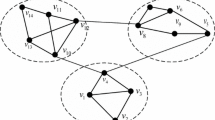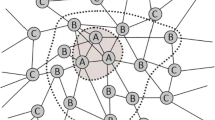Abstract
The relationship of friends in social networks can be strong or weak. Some research works have shown that a close relationship between friends conducts good community structure. Based on this result, we propose an effective method in detecting community structure in social networks based on the closeness of relations among neighbors. This method calculates the gravity between each neighbor node to core nodes, then makes judgement if the node should be classified in the community or not, and finally form the process of community detection. The experimental results show that the proposed method can mine the social structure efficiently with a low computational complexity.





Similar content being viewed by others
References
Lin YF, Wang TY, Tang R (2012) An efficient community network discovery model and algorithm [J]. Computer Research and Development 49(2):337–345
Girvan M, Newman ME (2002) Community structure in social and biological networks [J]. Proc Natl Acad Sci U S A 99(12):7821
Clauset A, Newman M, Moore C (2004) Finding community structure in very large networks [J]. Phys Rev E 70(6):264–277
Palla G, Derényi I, Farkas I et al (2005) Uncovering the overlapping community structure of complex networks in nature and society [J]. Nature 435(7043):814
Blondel VD, Guillaume JL, Lambiotte R et al (2008) Fast unfolding of communities in large networks[J]. J Stat Mech: Theory Exp 2008(10):155–168
Rosvall M, Bergstrom CT (2008) Maps of random walks on complex networks reveal community structure [J]. Proc Natl Acad Sci U S A 105(4):1118–1123
Raghavan UN, Albert R, Kumara S (2007) Near linear time algorithm to detect community structures in large-scale networks[J]. Phys Rev E Stat Nonlinear Soft Matter Phys 76(2):036106
Leung I, Hui P, Lio P et al (2009) Towards real-time community detection in large networks[j]. Phys Rev E 79(6):66107
Xie J, Szymanski BK, Liu X (2011) SLPA: Uncovering Overlapping Communities in Social Networks via a Speaker-Listener Interaction Dynamic Process[C]// IEEE, International Conference on Data Mining Workshops. IEEE Computer Society: 344–349
Wu ZH, Lin YF, Gregory S (2012) Balanced multi-label propagation for overlapping community detection in social networks[J]. J Comput Sci Technol 27(3):468–479
Yang J, Leskovec J. (2013) Overlapping community detection at scale:a nonnegative matrix factorization approach[C]// ACM International Conference on Web Search and Data Mining. ACM: 587–596
Wang K, Guo H (2014) An improved routing algorithm based on social link awareness in delay tolerant networks[J]. Wirel Pers Commun 75(1):397–414
Wang K, Qi X, Shu L et al (2016) Toward trustworthy crowdsourcing in the social internet of things [J]. IEEE Wirel Commun 23(5):30–36
Gleich D, Seshadhri C (2012) Neighborhoods are good communities [C]. In Proceedings of the 18th ACM SIGKDD Conference on Knowledge Discovery and Data Mining, Beijing
Author information
Authors and Affiliations
Corresponding author
Rights and permissions
About this article
Cite this article
Fan, X., Chen, Z., Cai, F. et al. Local Core Members Aided Community Structure Detection. Mobile Netw Appl 24, 1373–1381 (2019). https://doi.org/10.1007/s11036-018-0994-2
Published:
Issue Date:
DOI: https://doi.org/10.1007/s11036-018-0994-2




